
Platypuses are back in the Royal National Park for the first time in 50 years and at least one puggle was born last spring.
Ten platypuses were released into Australia’s oldest national park, just south of Sydney, last May, in the first project of its kind in NSW.
Last weekend the team found proof the platypuses are not only surviving in Royal National Park, but also breeding.
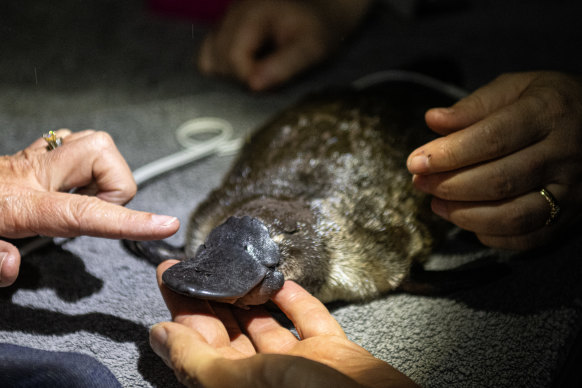
Delphi the platypus having a check-up before being released back into the Hacking River in the Royal National Park on Saturday night.Credit: Nick Moir
Dr Gilad Bino, from the Centre for Ecosystem Science at the University of NSW, said “words can’t describe” how thrilled his team was to catch a juvenile platypus on Sunday night.
“The platypus gods were smiling on us, they probably know we had good intentions,” Bino said.
Bino has tracking data that suggests all 10 animals are probably still alive and have colonised a large section of both the Hacking River and Kangaroo Creek.
Heading into a catch-and-release operation last weekend, Bino was hopeful of finding a juvenile because the animals converged during the breeding season last September, and there were credible sightings over summer.
On Saturday, the team caught one of the adult females released last year: Delphi, who hails from the Snowy River near Dalgety. On Sunday, they caught a healthy juvenile female about six months old.
How they became locally extinct
Dr Phoebe Meagher, the wildlife conservation officer at Taronga Zoo responsible for platypus conservation programs, said a platypus had not been seen in the park for decades before the release last year.
“It was cumulative effects from urbanisation and the river system becoming more fragmented over time,” Meagher said.
“Anecdotally, the nail in the coffin for the platypus population was a chemical tanker spill in the ’70s that apparently tipped over on the highway close by and all this gunk went into the river and the platypus was never seen again.”
Meagher said there were extensive checks to ensure the river was still good habitat, with clean water, earthen banks for burrowing, and a supply of macroinvertebrates such as dragonfly larvae and yabbies for food.
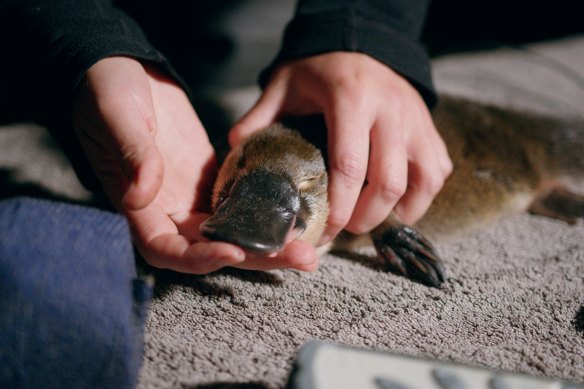
A juvenile female platypus about six months old found on Sunday night. At 850 grams it is almost the size of an adult, but it still has residual spurs not found in adult females.
Peabody Energy’s coal mine, Metropolitan Colliery, has spilled coal pollution in the river several times in the past few years, prompting legal action from the NSW Environment Protection Authority.
However, Bino said the team had collected data and was confident these incidents had not affected water quality or food availability for the platypuses.
Bino said the main predators were introduced species, especially foxes. The National Parks and Wildlife Service has been conducting extensive fox baiting in the area.
In colonial days platypus were also hunted for their fur, which is soft, dense and waterproof. The Powerhouse Museum has several items made of platypus fur in its collection including a blanket made of 80 skins, a cape, and a muff owned by the daughter-in-law of Sir Henry Parkes.
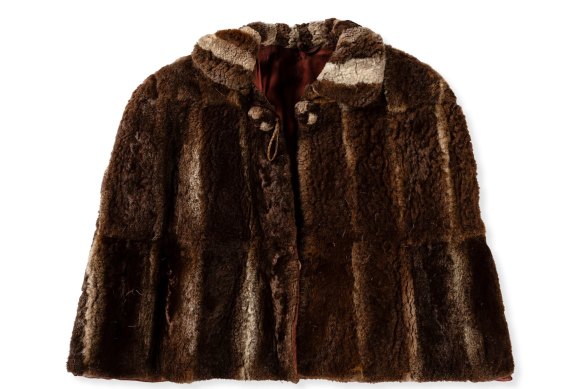
A cape made of platypus fur in the Powerhouse Museum.
Why aren’t they listed as threatened?
Platypus are found in south-eastern Australia and populations are declining, with some local extinctions. They are listed as endangered in South Australia and vulnerable in Victoria, but are not listed nationally or in NSW, Queensland or the ACT.
Loading
Bino was part of a push to list the platypus as threatened in 2020, but the federal government’s expert committee knocked it back for insufficient evidence.
NSW Environment Minister Penny Sharpe said on Saturday, while visiting the project, that finding a platypus was “extremely exciting”.
“We’ve got too many animals that are heading towards extinction and these kinds of programs are the hope that we need,” she said.
Behind the project
The project involves NPWS, UNSW and Taronga Zoo and World Wide Fund for Nature.
Meagher said the 10 platypuses were collected from all over the state to protect the source populations and ensure genetic diversity in the new location.
The captive platypuses were taken to a purpose-built facility at Taronga Zoo in Sydney where they stayed for two to four weeks.
Meagher said this allowed the team to strategically release the six females first to allow them to establish themselves. When the males arrived they would sense the female pheromones in the water.
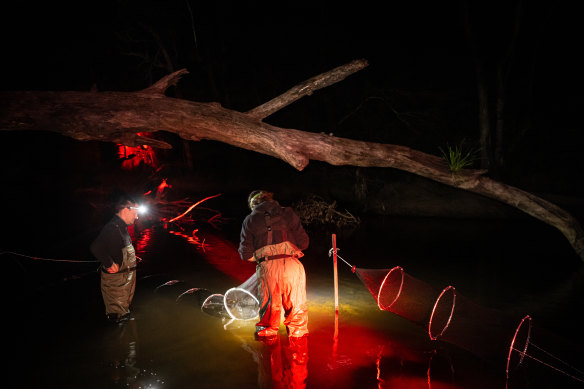
The scientific team discovering Delphi the platypus in the fyke net on Saturday night.Credit: Nick Moir
Taronga is now investing in a mega-facility in Dubbo that will hold 50 platypuses, which Meagher said would allow the zoo to rescue the animals during droughts.
At Taronga the platypus had acoustic trackers – about the size of a paracetamol capsule – implanted. Systems along the river ping when the animals swim by.
The trackers detected eight platypuses this month. Bino said the other two, which were last detected in January, regularly swim beyond the range of the trackers.
The benchmark for success is a 50 per cent survival rate after 12 months, so the project exceeded expectations.
Bino said this was the first platypus translocation – where the animals are moved from one location to another – in NSW, but had been done a few times over the past century in South Australia and Victoria.
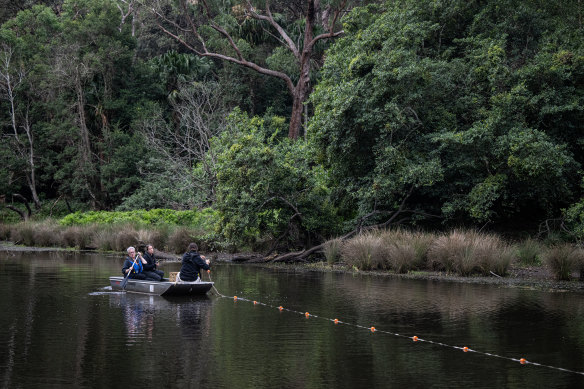
NSW Environment Minister Penny Sharpe and the UNSW researchers setting the mesh net in the Hacking River on Saturday night.Credit: Nick Moir
The catch-and-release operation involved setting traps at several sites on the river. The captured animals were sedated to allow measurements and blood and fur samples to be taken, and then released a few hours later. The juvenile was microchipped before release.
How the catch-and-release operation worked
In the deeper water, the scientists used a boat to set up a mesh net (or gill net). In the shallow areas, they used fyke traps, which funnel the platypuses into a mesh cylinder with access to air.
Delphi weighed about one kilogram, small but similar to last May. If she was one of the breeding females, she would have lost weight while feeding up to two puggles.
The juvenile platypus was 850 grams. By this age, she looks similar to an adult except for her residual spurs.
Adult males have venomous spurs on their hind legs, and female puggles are born with residual spurs that they later lose.
How to see platypuses in the Royal National Park
There are picnic areas along the Hacking River and boats for hire at Audley Weir, though there are some restrictions on where you can take watercraft.
Loading
Bino said the best way to see a platypus is to visit at dawn or dusk and to stay quiet. He added it was important not to harass a wild platypus, and to stay on the tracks to avoid collapsing a burrow on one of the riverbanks.
Sharpe said she hoped it would inspire people to care for platypuses and other wildlife.
“It’s one of the most wonderful things to think that just south of Sydney, you can come and have a picnic and you might just see a platypus,” Sharpe said.
“You can’t see these animals and not go ‘why aren’t we looking after them and what more can we do?’ ”
Get to the heart of what’s happening with climate change and the environment. Sign up for our fortnightly Environment newsletter.









 Add Category
Add Category